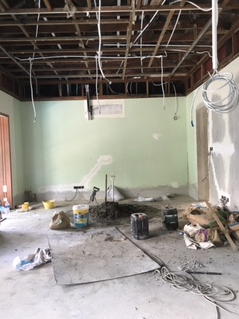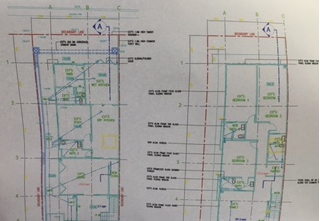Internship « Phaser Design », Singapore 2018
Judith Colleemallay
1. Introduction
From the 20th of June to the 5th of July, I went to Singapore in order to do my internship in a small local design company. The company is called « Phaser Design » and is located at 60 Paya Lebar Road (#07-54, 409051 Singapore) in the East of the town. It employs three people, one man and two women, one of them being on maternity leave during my work placement. I accompanied one of the designers to all the different construction sites whereas his colleague was working at their office, taking care of administration tasks and looking for decorating ideas.
After his national service – which is mandatory for all boys in Singapore -, the designer, whom I accompanied, studied at Nanyang Academy of Fine Arts (NAFA). The second designer studied at Lasalle-SIA Regent Academy of Fine Arts. They both graduated with an interior design diploma. That was when they decided to launch a company specialising in renovation and design, for its main business. "Phaser Design & Contracts Pte Ltd" was founded in 2013.
« Phaser Design » wished a rather slow build up and they did not want to become « too big, too fast », because there is already a lot to manage and for now there is more than enough work, according to the founders. They primarily look for proximity with their clients, suppliers, workers and solicit local architects, plumbers, workers, etc. That being said, they are currently thinking about expanding and hiring another designer.
A designer's job consists in drafting what he refers to as a drawing. He then imagines how he can design and renovate the place according to the client’s instructions. Therefore, he accompanies his clients through all the process: from the beginning of a fledgling idea through the whole conception process of the plan, the renovations or the construction towards the designing (choosing tiles, floors, wallpapers, etc.) until the furnishing and decorating.
2. My internship at « Phaser Design »
During my internship, we went to all of the different projects sites "Phaser Design" was working on. Most of them were still under construction and that is how I got to see a side of design which many people tend to forget. Generally, when we hear the word « design », we immediately think of the finished project; we only concentrate on the glamorous side of things when really there is so much more to it. The designers have a lot of deadlines they have to respect, that’s why it can become quite stressful when there is a piece missing, when the workers are not working properly or an unexpected situation comes up. The internship allowed me to break all the clichés about design.
While renovating a place or during constructions, the process is split in two parts. First, there are the « wet-works », meaning everything that has to do with liquid materials such as laying the tiles, using concrete, bricklaying, etc. Only when those works are completed, the « dry-works » can take place; carpentry, joinery, plumbing, etc. After this, the furnishing and decorating can begin. The designer always has to be aware of every progress on every project he is working on so that he can tell his client about every little detail and give him any information he may need at any time. That means that the designer has to go to all his sites at least once a day to check the development.
 site under construction
site under construction
Before a contract can be drawn up, the client comes to the designer with the plans of the place he wants to renovate, which is not necessarily his home. During my internship, I saw not only houses under renovation but also offices, nurseries, etc. The designer then drafts a layout with 3D programs and other softwares. He has to consider the client’s expectations; a bathroom connected to the bedroom (master bedroom), a walk-in closet, etc. He also has to be aware of how his clients live, because their culture and traditions may influence the style and the way the project will be furnished and decorated.
After consulting his client, the designer will prepare the drawings but he will also design a mood board with all the different materials he used in his sketch (carpets, wallpapers, curtains, tiles for the floors and walls, etc.). This mood board will be presented to the client in order to help him to visualize what the final project might look like. The designer usually has to redo his plans a few times before his client is satisfied. He sometimes has to sell the idea behind his mood board, as he possesses the ability to visualize his client living his lifestyle in the place he created and designed; he can imagine what the place will look like when it’s done. The client on the other hand, often has more problems to visualize and therefore cannot accept the choices the designer made. That is when the designer will have to convince his client; visualization is basically the designer’s « talent ».


drawing mood-board
While the site is under construction, the designer also sometimes helps out on smaller tasks and touch-ups but he mainly pays attention to how the works are down. He controls everything from where to place the lights and the air con, to how to arrange the furniture. Obviously, he helps choosing the furniture, adjusting the decorations, he continuously checks the working progress, he is in contact with the workers and buys fabrics and materials from his supplier while paying attention to the budget his client set up. He also has to pay attention to roof leaking, lighting, electricity, cable connections, plugs, phone cables, pipework, etc. Unfortunately, it can be difficult to find a compromise between budget, price, quality and the design ideas.
 finished project
finished project
During my internship in 3ème , which I made at « Dassault Systèmes », I learnt to use a 3D software called « HomeByMe », which has always been one of my interests. What makes it special is the fact that it is connected to the different furnishing shops; therefore, it is easy to design the space with specific brands and it facilitates the choices as you can filter the products under different criteria such as material, price, colour, etc. I use this software during my free time because I enjoy designing and imagining projects and I also had the opportunity to explain to the designers how it works.
3. Conclusion
Being so far away in a country with such an entirely different culture was certainly very beneficial to me. I lived through a few challenges; my plane was almost cancelled before my departure because of a broken piece in the engine. As if this wasn’t enough, I fell sick two days after my arrival and I felt so much pain that I had to spend a whole day in the hospital. Just as I thought nothing more could happen to me, I got stung by a bug and my foot was so swollen I couldn’t walk properly. Luckily, I had no problems adjusting to the heat, the humidity, the food or the culture, as I like this weather and it was my third time travelling to Singapore. Even with those little twists I still had an amazing time in Singapore; this place is very dear to my heart and I really enjoy the lifestyle there and all of the things that make this city so special (cleanliness, discipline, safety & security, modernity), as everything seems very thought through. Singapore truly is the definition of the concept of a « smart city ».
To conclude, definitely I was exposed to a different way of life, which represented an interesting experience. In order to prepare myself to achieve this experience, I informed myself about Singapore, its culture and how the inhabitants think. I also looked up some specific vocabulary I might need during my internship but I had to get used to the local accent. I also wrote down everything that was important for me to know for the trip, especially for the flight. But if there is one thing I learnt from this trip, it is that even if you plan everything and prepare yourself in the best way possible, there will always be something coming up that might mess up that plan. I now understand why flexibility is a required quality in all job offers. In this situation it is important to keep one’s cool and look at the positive side of things. Every turn of events has a silver lining in the end. Sometimes you just have to stop thinking everything through and start living, enjoying and just let life take its course, just let things happen.
 skyline Singapore
skyline Singapore